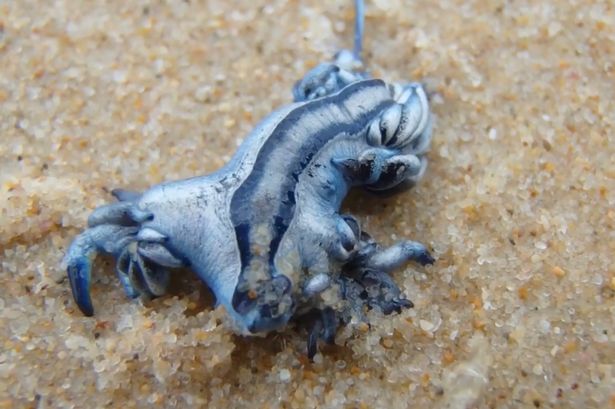World
Tourists Face Sea Ban on Costa Blanca Due to Deadly Blue Dragons

Tourists visiting Spain’s Costa Blanca are facing restrictions on entering the water following the sighting of dangerous marine creatures known as blue dragons. This ban, which affects a seven-mile stretch of coastline, was implemented in the municipality of Guardamar del Segura after two specimens of the Glaucus atlanticus were reported at Vivers Beach.
The blue dragon, often described as “the most beautiful killer in the ocean,” poses significant risks due to its potent sting. These striking sea slugs, which can grow to about 1.5 inches in length, feed on the venomous Portuguese man o’ war and other dangerous marine life. In doing so, they absorb and store the stinging cells, resulting in a sting that is significantly more powerful than that of their prey.
Symptoms of a blue dragon sting can be severe, including nausea, pain, vomiting, and acute allergic contact dermatitis. Local authorities are taking preventive measures to ensure public safety. According to Guardamar del Segura’s Mayor, Jose Luis Saez, the swimming ban remains in effect until further notice. He emphasized the importance of avoiding contact with these creatures, stating, “Despite its bright and striking colour, people should stay away from this animal because of its sting.”
In response to the sightings, the Guardamar del Segura Town Hall has initiated a monitoring operation to detect additional blue dragons carried by ocean currents. The mayor urged anyone who encounters one of these creatures to alert lifeguards and refrain from touching it, even while wearing gloves. In the event of a sting, individuals are advised to wash the affected area with salt water and seek medical attention.
While the ban has been enforced, many beachgoers were seen at Vivers Beach, with some ignoring the restrictions and entering the water. Lifeguards have been instructed to remind visitors of the prohibition using loudhailers, although sunbathers are still permitted to enjoy the beach without swimming.
A similar incident occurred at Santa Barbara Beach near La Linea de la Concepcion, where red flags were raised following the discovery of six blue dragons on the shoreline. The beach was reopened the next day with a yellow warning flag in place.
As authorities continue to monitor the situation, tourists are encouraged to stay informed about safety measures and heed warnings regarding these potentially lethal sea creatures.
-

 Health3 months ago
Health3 months agoNeurologist Warns Excessive Use of Supplements Can Harm Brain
-

 Health3 months ago
Health3 months agoFiona Phillips’ Husband Shares Heartfelt Update on Her Alzheimer’s Journey
-

 Science1 month ago
Science1 month agoBrian Cox Addresses Claims of Alien Probe in 3I/ATLAS Discovery
-

 Science1 month ago
Science1 month agoNASA Investigates Unusual Comet 3I/ATLAS; New Findings Emerge
-

 Science4 weeks ago
Science4 weeks agoScientists Examine 3I/ATLAS: Alien Artifact or Cosmic Oddity?
-

 Science4 weeks ago
Science4 weeks agoNASA Investigates Speedy Object 3I/ATLAS, Sparking Speculation
-

 Entertainment4 months ago
Entertainment4 months agoKerry Katona Discusses Future Baby Plans and Brian McFadden’s Wedding
-

 Entertainment4 months ago
Entertainment4 months agoEmmerdale Faces Tension as Dylan and April’s Lives Hang in the Balance
-

 World3 months ago
World3 months agoCole Palmer’s Cryptic Message to Kobbie Mainoo Following Loan Talks
-

 Science4 weeks ago
Science4 weeks agoNASA Scientists Explore Origins of 3I/ATLAS, a Fast-Moving Visitor
-

 Entertainment4 months ago
Entertainment4 months agoLove Island Star Toni Laite’s Mother Expresses Disappointment Over Coupling Decision
-

 Entertainment3 months ago
Entertainment3 months agoMajor Cast Changes at Coronation Street: Exits and Returns in 2025









